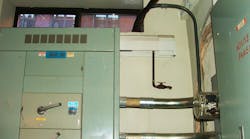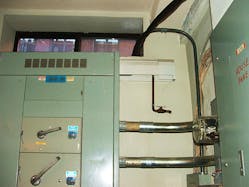How well do you know the Code? Think you can spot violations the original installer either ignored or couldn't identify? Here's your chance to moonlight as an electrical inspector and second-guess someone else's work from the safety of your living room or office. It's your turn to identify the violation.
Hint: Above board switchboard baseboard?
Find the Answer
The forced hot water baseboard heater installed directly on top of the switchboard creates a Code violation, and leaves me wondering, “Who thought this was a good idea?”
Section 110.26(E) requires switchboards to be installed in dedicated spaces and protected from damage. For indoor installations, Sec. 110.26(E)(1)(a) requires a clear space to be provided above switchboards, panelboards, or motor control centers. No piping, ducts, or other equipment foreign to the electrical equipment is permitted to be installed in the space directly above the switchboard, panelboard, or motor control center for a height of 6 ft above the electrical equipment or to the structural ceiling — whichever is lower.
This clear space also extends down to the floor below the electrical equipment. Nothing except electrical equipment is permitted in this zone. If this baseboard heater develops a leak, the water will most certainly flow into the switchboard. This could easily result in a disaster for the building occupants and owner. Even if some leak protection apparatus was provided between the baseboard heater and the switchboard, it would still be a violation because the leak protection apparatus is not permitted to be located in the dedicated space either.





